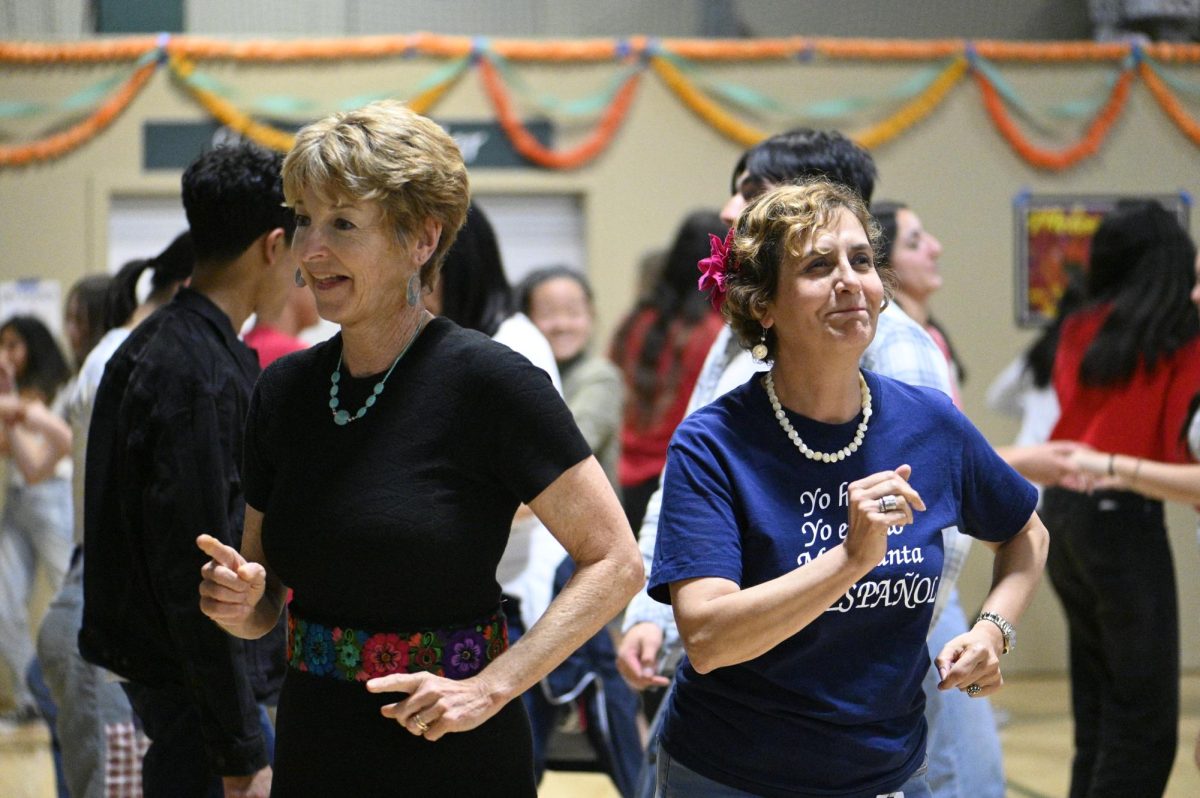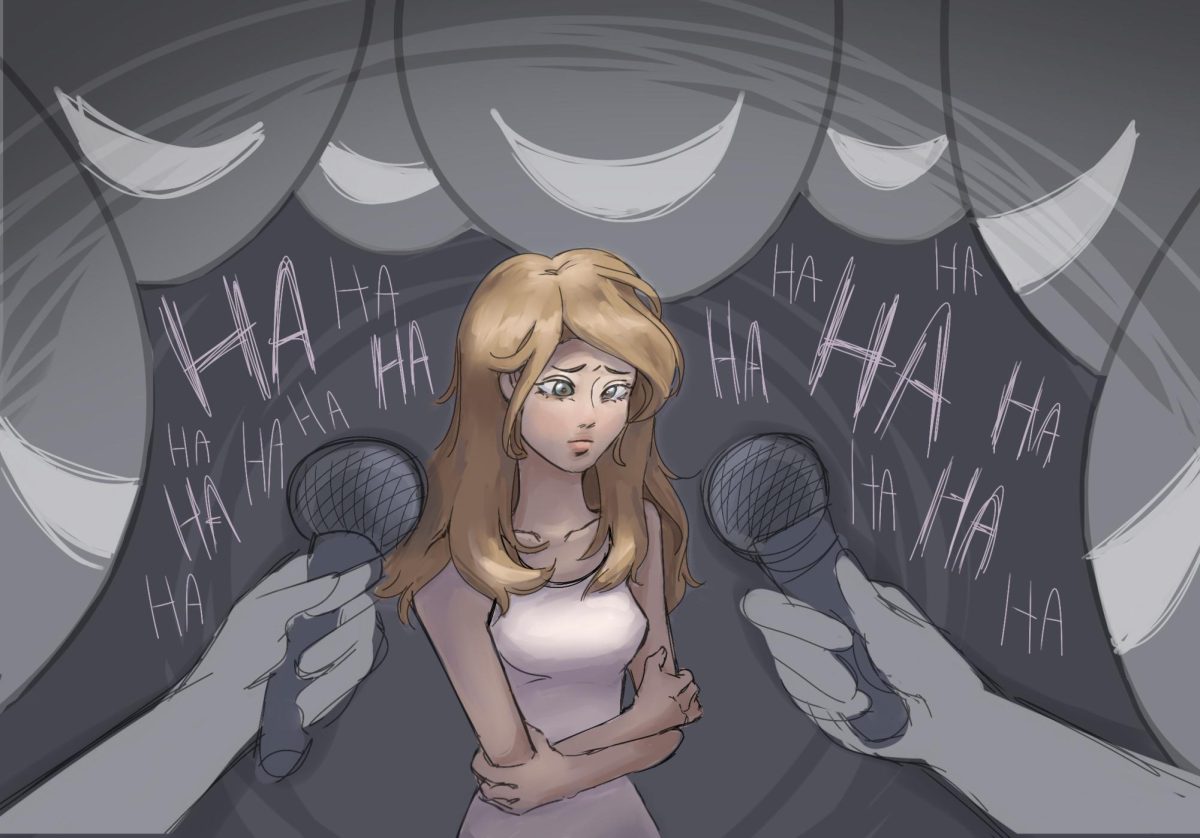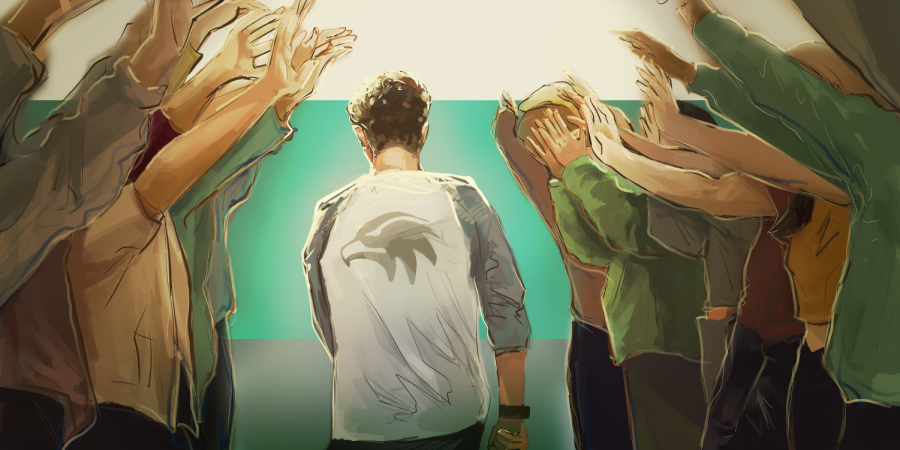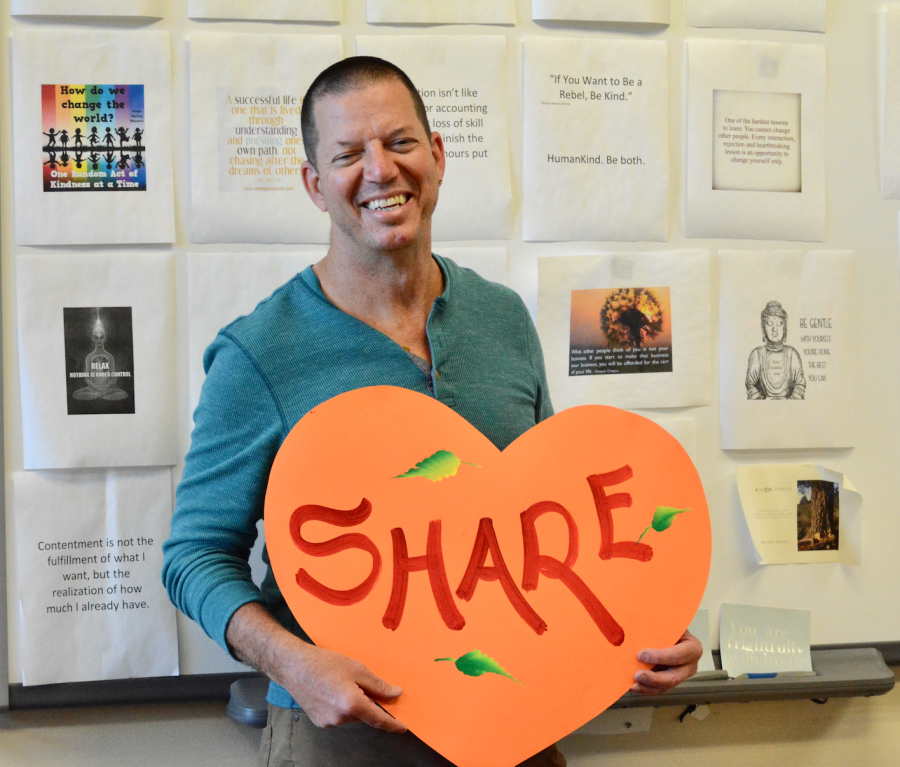On Wednesday, April 18, 43 performers took over the stage at the Blackford theatre at their debut of The Drowsy Chaperone during preview night.
The plot of the show is a framed story that revolves around a man in his apartment and eventually transforms into his imagination. Contrary to the more serious mood of the musicals from the past two years, Pippin and Les Miserables, this year’s spring musical is a comedy. Though set in the present day, the inner narrative of the story takes place in the liveliness of the 20s and revolves around joy and happiness.
With colorful costumes, tap dancing, innovative set designs, and a group of actors and directors who have been rehearsing since February, the musical is full of surprises.
Principal characters, directors, and tech crew members exposed the behind-the-scenes action of the show in interviews with The Winged Post.
Take a leap in time back to the 1920s. At one moment, you witness the nuances that occur in a man’s apartment; in another, you delve into his imagination, one with no limits and no restrictions. Welcome to The Drowsy Chaperone.
Lead characters:
Whether this musical marks the beginning of their career or the end of their pastime, Tristan Killeen (12), Lauren Pinzas (12), and Noel Witcosky (12), a few of the principle characters, described their relationships with their characters and the significance of this specific show.
Tristan plays the narrator of the show, the only natural character, and guides the audience through the fast-paced and complex plot.
Because this is his first lead role in any musical, the hours of arduous work has been an entirely new experience for him. He stated that one of the most difficult aspects of preparing is memorizing all of his lines. Another is mentally preparing to be on stage the entire duration of the show.
“You need to be able to do all the transitions in your head and know where you are without having any time to drop character,” he said when describing the challenges of playing a lead character.
Tristan relates to his character since both try to “escape the dreary horrors of the real world for a little while,” by, relative to the play, reminiscing on past moments.
Noel plays Janet, the young movie star who steals the spotlight. She dresses to impress and is “infatuated by all of the drama and glamour that comes with being a movie star.”
In that sense, Noel struggles to identify with Janet. She describes herself as an introvert at times so this role has strengthened her confidence and pushed her to explore the different acting styles that come with playing a pretentious and materialistic character.
“Every single year that I’ve been [in the Performing Arts Department], Ms. Lang-Ree has really pushed me to step out of my boundaries and just step out of the box,” she said.
Noel states that she will miss the theatre community the most because of the perpetual support from the cast members to the directors.
Lauren describes her character as a sardonic and sarcastic old woman who is jealous and envious of Janet. She always puts in her 110 percent effort into everything, and in that way, Lauren finds herself similar to her role.
From performing in musicals like Pippin to Les Miserables over the years, Lauren believes that she has experienced the full spectrum of theatrical performances. The Drowsy Chaperone will be her debut singing solo, which she admits has made her more nervous for the upcoming shows.
“I realized that people aren’t mean, they are actually really supportive [to the performers on stage],” she said.
She clearly notes that her favorite aspect of the rehearsal process is the costumes and the moment when the director says, “and we have a show,” marking the end of rehearsals and the beginning of performances.
Tristan, Noel, and Lauren are only three of the twelve leading roles in The Drowsy Chaperone.
Directors:
Director Laura Lang-Ree chose The Drowsy Chaperone because of the wide breadth of experience that the musical offers.
As a play within a play, the outer frame of the narrative takes place in the present day while the internal story goes back to the 20s. Therefore, the musical offers two different genres for the performers to experience.
“One of the goals that we have in the conservatory is to have a broad range of experiences and so I try to have different styles of musicals every year,” she said. “This year, it was time for a more classically oriented musical and one that was just about fun and joy and that trains our students in vastly different ways.”
Lang-Ree likes that the musical offers the opportunity for several students to take on principal roles; there are 12-15 main characters. Additionally, the musical requires a prominent ensemble, which is what she considers to be the most significant part of the show.
“The goals are to learn how to be a very strong ensemble from the get go. Everybody is of equal importance,” she said. “You can take anybody and make a lead look special but when you can take 43 people and train them how to sing and dance and move an audience together, that’s much more important.”
Lang-Ree reflected this idea when describing the importance of proper stage mapping so that everyone is seen and space is used effectively. Another challenge was the lack of scene changes or stage directions in the original script.
“They almost did it as a trick for directors,” she said.
“There’s no direction whatsoever in terms of when [something] happens or what it should be or what it shouldn’t be, so it leaves things wide open in terms of interpretation.”
Upper School Performing Arts teacher Catherine Snider is the musical director for the show. As a part of her job, she teaches the cast about musical aspects of the show and conducts the orchestra come show time, assisting the director in ensuring that the show flows musically.
Snider identifies that one of the musical challenges of the show is singing in the correct style of the time period.
“Right now, that big, belty, high, power voice is really popular,” she said. “In the 20s, it [had] to sound more clipped, their accent [had] to be different, [and] they [had] to breathe in different places.”
Snider identifies that teaching the performers to sing in the style of the 20s is very different from what they usually learn, especially since what is normally considered “correct” on Broadway changes as the years pass and the Upper School has not previously done a musical from that era.
Tech Crew:
An integral part of this process is the often-overlooked tech crew. This 19-member team is crucial to the success and flow of the show; they build the scenery and background of the main stage, manage the props during scenes, and organize all of the technical aspects from lighting to audio.
Once the musical was announced, Paul Vallerga of the Performing Arts department began outlining and planning the details of the set on paper.
Over Spring break, the staff built the physical features of the musical, which include platforms, flats, and back drops. The week prior to show week is when the crew actually begins most of the work.
As the first time this musical has been done in the performing arts department, Brian Larsen, Upper School Technical Director indicates that the lack of a frame of reference to design the set off of is an entirely new experience for not only him, but also for Vallerga and the crew members. They have noted that difficulties comprise fitting all 43 cast members on stage and creating the complex scenery.
Additionally, contrary to previous performances, every single member is needed due to the large number of costumes and the multiple big background shifts that occur, including the transformation from reality to a man’s imagination.
With seven years of experience behind the stage, Simon Orr (11) said that the main difficulty about working on set is placing the constructed items on stage since nothing ever fits the way it is expected.
“It’s nice to be able to see how things get put together rather than just the finished project,” Simon said.
Vallerga said that one of the most interesting parts of the show to look forward to in terms of the set design is going to be a surprise for the audience at the end of the performance.
Guest directors:
Guest directors and designers for the show include costume designer Caela Fujii and choreographer Katie O’Bryon, both of whom have been working with the Upper School directors for the past seven to eight years.
“I like working with the adults here and I like working with the kids as well; everyone is pretty organized and very professionally behaved, which is very nice at school,” Fujii said. “It’s great that Harker hired theatre professionals [for] the students.”
Before commencing her work on this year’s production of The Drowsy Chaperone, she had never seen the play before. This is the first time that she designed a show for the Upper School without having a foundation to base her work off of.
“I couldn’t rely on productions from the past,” she said. “There were no stage directions to script. That was really difficult.”
Fujii’s job essentially entails finding clothes, wigs, and shoes; building costumes if the need arises; and managing hair and makeup. She describes this year’s costumes as “fun, colorful, [and] art deco,” but “no weirder than normal.” She incorporated a lot of geometric shapes into the clothing this year as well.
In addition to Fujii, Lang-Ree hired O’Bryon from the Peninsula Youth Theatre to choreograph and manage the dance routines in the musical.
“There’s a big tap number that’s really reflective of the 20s dance style [and] Charleston and big group numbers,” performer Rohan Chandra (11) said.
The dancing, along with the costumes, portrays the light-heartedness characteristic of The Drowsy Chaperone.
The annual spring musical premiered on Thursday night at 7 p.m., with subsequent shows occurring tonight and Saturday, at 2 p.m. and 7 p.m., at the Blackford theatre.































![Setter Emma Lee (9) sets the ball to the middle during the match against Pinewood on Sept. 12. “[I’m looking forward to] getting more skilled, learning more about my position and also becoming better friends with all of my teammates, Emma said.](https://harkeraquila.com/wp-content/uploads/2023/09/DSC_4917-2-1200x795.jpg)















































































![“[Building nerf blasters] became this outlet of creativity for me that hasnt been matched by anything else. The process [of] making a build complete to your desire is such a painstakingly difficult process, but Ive had to learn from [the skills needed from] soldering to proper painting. Theres so many different options for everything, if you think about it, it exists. The best part is [that] if it doesnt exist, you can build it yourself, Ishaan Parate said.](https://harkeraquila.com/wp-content/uploads/2022/08/DSC_8149-900x604.jpg)


![“Animation just clicked in a way. I had been interested in art, but that felt different. [Animation] felt like it had something behind it, whereas previous things felt surface level. I wasnt making that crazy of things, but just the process of doing it was much more enjoyable, Carter Chadwick (22) said.](https://harkeraquila.com/wp-content/uploads/2022/08/Screen-Shot-2022-08-16-at-9.44.08-AM-900x598.png)


![“When I came into high school, I was ready to be a follower. But DECA was a game changer for me. It helped me overcome my fear of public speaking, and its played such a major role in who Ive become today. To be able to successfully lead a chapter of 150 students, an officer team and be one of the upperclassmen I once really admired is something Im [really] proud of,” Anvitha Tummala (21) said.](https://harkeraquila.com/wp-content/uploads/2021/07/Screen-Shot-2021-07-25-at-9.50.05-AM-900x594.png)



![“[Volleyball has] taught me how to fall correctly, and another thing it taught is that you don’t have to be the best at something to be good at it. If you just hit the ball in a smart way, then it still scores points and you’re good at it. You could be a background player and still make a much bigger impact on the team than you would think,” Anya Gert (’20) said.](https://harkeraquila.com/wp-content/uploads/2020/06/AnnaGert_JinTuan_HoHPhotoEdited-600x900.jpeg)

![“Im not nearly there yet, but [my confidence has] definitely been getting better since I was pretty shy and timid coming into Harker my freshman year. I know that theres a lot of people that are really confident in what they do, and I really admire them. Everyones so driven and that has really pushed me to kind of try to find my own place in high school and be more confident,” Alyssa Huang (’20) said.](https://harkeraquila.com/wp-content/uploads/2020/06/AlyssaHuang_EmilyChen_HoHPhoto-900x749.jpeg)













![“My slogan is ‘slow feet, don’t eat, and I’m hungry.’ You need to run fast to get where you are–you arent going to get those championships if you arent fast,” Angel Cervantes (12) said. “I want to do well in school on my tests and in track and win championships for my team. I live by that, [and] I can do that anywhere: in the classroom or on the field.”](https://harkeraquila.com/wp-content/uploads/2018/06/DSC5146-900x601.jpg)

![“I think getting up in the morning and having a sense of purpose [is exciting]. I think without a certain amount of drive, life is kind of obsolete and mundane, and I think having that every single day is what makes each day unique and kind of makes life exciting,” Neymika Jain (12) said.](https://harkeraquila.com/wp-content/uploads/2017/06/Screen-Shot-2017-06-03-at-4.54.16-PM.png)





















